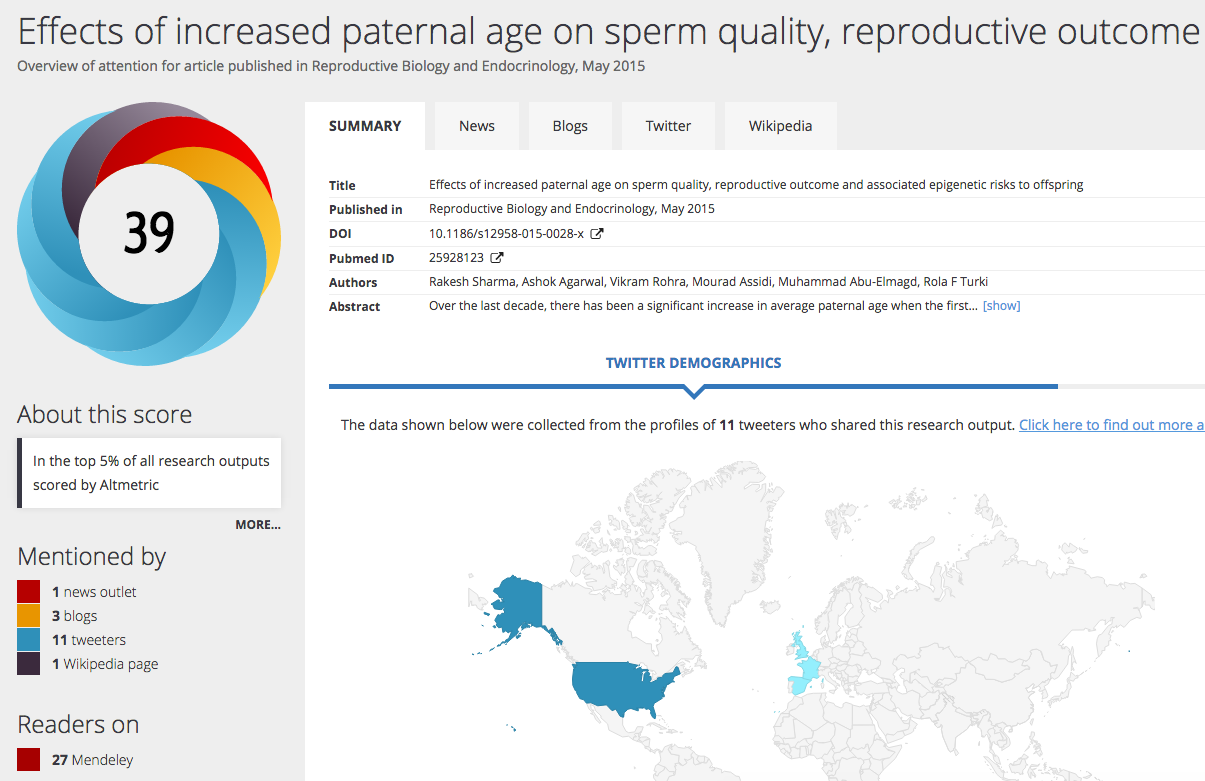
At Altmetric.com, we collect a huge amount of attention data relating to scholarly research. Every day, thousands of unique articles are mentioned online, and we see academics and members of the public alike participating in conversations about research.
We’ve chosen to examine the online attention data for four articles published in BioMed Central Global Health journals. These articles have all been mentioned quite recently, and of particular interest is the ways in which they have been discussed in non-academic online sources.
1. Effects of increased paternal age on sperm quality, reproductive outcome and associated epigenetic links to offspring
Reproductive Biology and Endocrinology
This 2015 paper in Reproductive Biology and Endocrinology asks whether fertility levels decrease as men age, as they do with women. Researchers from the Cleveland Clinic and King Abdulaziz University examined results from previous sperm analyses and reported that advanced paternal age increases the DNA fragmentation in sperm, which can have a negative impact on the success of fertility treatment and can also lead to the increased incidence of disorders such as autism and schizophrenia.

This research was mentioned in two news stories from The Conversation. In one of these pieces, the research was examined in the context of feminist debates surrounding fertility.
The author of this story argued that age should be an important decision-making factor for men as well as women for choosing when to have children, as the research suggests that the ‘ticking clock’ issue does not, (as has been suggested previously) apply exclusively to women.
The Reproductive Biology and Endocrinology paper was also mentioned in three blog posts. One blogger made a very interesting point that current tests for Down Syndrome in foetuses should be changed to incorporate this kind of research, as current probability forecasts are generated from an algorithm that calculates risk based on the blood results and age from the maternal side only.
Read the paper
View the Altmetric details page
2. Vulnerability of populations and the urban healthcare systems to nuclear weapon attack – examples from four American cities
International Journal of Health Geographics

The authors of this 2007 paper in the International Journal of Health Geographics predicted the number of casualties and reach of radiation damage that would be caused if a nuclear bomb were to be detonated in New York City, Washington DC, Chicago, or Atlanta.
The researchers then called for improved prediction models and more complete data, in order to maximize the effectiveness of contingency plans for such events.
In addition to being a co-author of the paper, researcher Cham Dallas later wrote about his findings for news outlets The Conversation, Phys.org, and Homeland Security Newswire. This is a good example of a researcher presenting their findings in an opinion-based piece to a non-academic audience.
Although Altmetric usually picks up the majority of online attention for an article in the first few weeks following publication, the spike in news coverage for this study occurred much later on and was driven by the co-author’s own writing in mainstream outlets.
Read the paper
View the Altmetric details page
3. Diet, exercise or diet with exercise: comparing the effectiveness of treatment options for weight loss and changes in fitness for adults (18-65 years old) who are overfat, or obese; systematic review and meta-analysis
Journal of Diabetes and Metabolic Health Disorders

It seems fitting to talk about this 2015 Journal of Diabetes and Metabolic Health Disorders study in the month of January, as the question of how to lead a healthy lifestyle is always a hot topic following the festive season. After
Analyzing results of previous human trials, James E. Clark from Manchester Community College concluded that resistance (or strength) training was more effective than endurance training when combined with a healthy diet.
The Twitter demographics map on the Altmetric details page shows that tweeters from Brazil, Spain and Finland, as well as the USA and UK mentioned the research. Interestingly, the demographic breakdown shows that 70% of these tweets were from non-academic members of the general public, as opposed to researchers or healthcare professionals.
If we look at the content of some of the tweets, this paper also seems to prove a point for many people who engage in debates about whether resistance training, endurance training, or cardio is the most effective form of exercise.
Read the paper
View the Altmetric details page
4. International regulatory landscape and integration of corrective genome editing into in vitro fertilisation
Reproductive Biology and Endocrinology
This 2014 review article in Reproductive Biology and Endocrinology focuses on CRISPR gene modification as a way of preventing hereditary disease. Researchers from Hokkaido University discussed the legislature on the issue from different countries and reported that 29 out of 30 countries surveyed had bans on genetic modification, but that the USA was not one of these.
This article attracted a significant amount of mainstream news and blog coverage. Notably, a story from The New Scientist touched on on the fact that some researchers had called for a moratorium on research into CRISPR techniques on the basis that they currently present too many legal, social, and political issues.
Read the paper
View the Altmetric details page
Who is engaging with your research?
In this post, I hope I’ve shown that Altmetric data can be a useful way of looking at who is engaging with research online, and how news reporters and bloggers are presenting important research findings in the context of current debates.
In addition to helping researchers view and monitor the attention paid to their work, Altmetric data can be used to discover other interesting or relevant scholarly content to read.
In addition to helping researchers view and monitor the attention paid to their work, Altmetric data can be used to discover other interesting or relevant scholarly content to read.
The fact that all BioMed Central articles are Open Access may also have influenced the kinds of attention the articles ended up receiving. The relationship between Open Access and altmetrics is fascinating in its own right, and is still being actively explored (see this blog post, for example).
About Altmetric
Altmetric is a London-based data science company. We help researchers, publishers, institutions, and funders see the conversations surrounding their research.
Comments